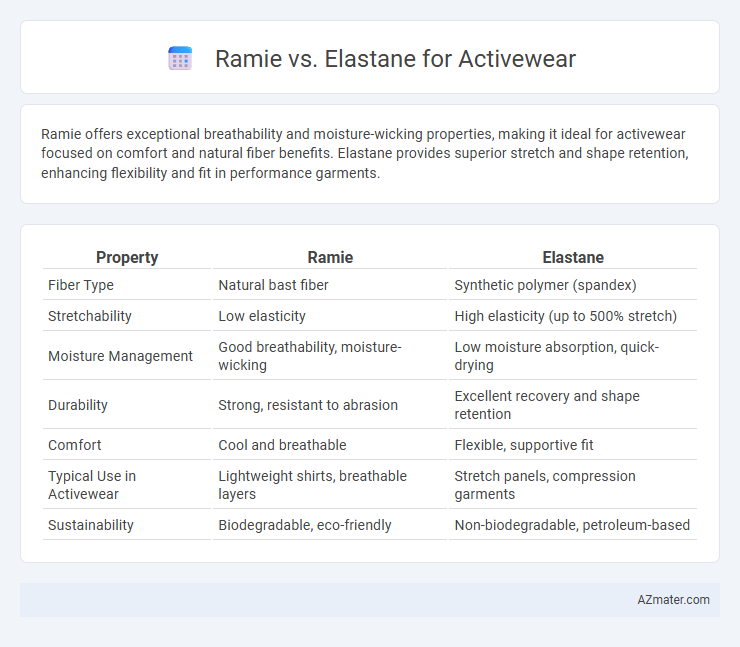Ramie offers exceptional breathability and moisture-wicking properties, making it ideal for activewear focused on comfort and natural fiber benefits. Elastane provides superior stretch and shape retention, enhancing flexibility and fit in performance garments.
Table of Comparison
| Property | Ramie | Elastane |
|---|---|---|
| Fiber Type | Natural bast fiber | Synthetic polymer (spandex) |
| Stretchability | Low elasticity | High elasticity (up to 500% stretch) |
| Moisture Management | Good breathability, moisture-wicking | Low moisture absorption, quick-drying |
| Durability | Strong, resistant to abrasion | Excellent recovery and shape retention |
| Comfort | Cool and breathable | Flexible, supportive fit |
| Typical Use in Activewear | Lightweight shirts, breathable layers | Stretch panels, compression garments |
| Sustainability | Biodegradable, eco-friendly | Non-biodegradable, petroleum-based |
Introduction to Ramie and Elastane in Activewear
Ramie, a natural fiber derived from the stalks of the Chinese nettle plant, offers excellent breathability, moisture-wicking properties, and durability, making it a sustainable choice for activewear. Elastane, also known as spandex or Lycra, is a synthetic fiber known for its exceptional elasticity and shape retention, providing flexibility and comfort during high-intensity activities. When combined, ramie enhances natural comfort and eco-friendliness, while elastane contributes stretch and support, creating performance-driven activewear garments.
Fiber Origins and Production Processes
Ramie, a natural fiber derived from the stalks of the Chinese nettle plant, undergoes a labor-intensive process involving retting, decortication, and degumming to extract its lustrous, strong fibers ideal for breathable activewear. Elastane, a synthetic fiber created through a complex petrochemical process involving the polymerization of polyurethane, offers exceptional elasticity and shape retention essential for form-fitting activewear garments. The contrasting origins--plant-based for ramie and petroleum-based for elastane--significantly influence their production scalability, environmental impact, and performance characteristics in activewear applications.
Key Physical Properties Compared
Ramie fibers offer excellent moisture absorption and natural breathability, making them suitable for activewear requiring comfort during intense workouts. Elastane provides exceptional stretchability and recovery, allowing garments to maintain shape and support dynamic movements. Combining ramie's durability with elastane's elasticity creates high-performance activewear optimized for both comfort and flexibility.
Moisture Management and Breathability
Ramie fibers exhibit excellent moisture-wicking properties and natural breathability, making them ideal for activewear designed to keep the skin dry and comfortable during intense exercise. Elastane offers superior stretch and flexibility, but it lacks inherent moisture management and breathability, often requiring blends with other fabrics to enhance performance. Combining ramie with elastane creates activewear that balances comfort, breathability, and moisture control for optimal athletic performance.
Stretch and Flexibility Analysis
Ramie offers natural breathability and moderate stretch, making it less flexible compared to elastane, which is renowned for its exceptional elasticity and ability to retain shape under intense movement. Elastane fibers typically provide up to 500% stretch, ensuring superior flexibility and recovery in activewear, essential for dynamic activities. Combining ramie with elastane enhances fabric durability and moisture-wicking properties while maintaining optimal stretch and flexibility for athletic performance.
Durability and Wear Resistance
Ramie exhibits high durability and excellent wear resistance due to its natural strength and stiffness, making it suitable for activewear that demands long-lasting fabric performance. Elastane, known for its exceptional elasticity, provides significant stretch and recovery but tends to be less resistant to abrasion and wear over time. Combining ramie with elastane in activewear enhances overall fabric resilience while maintaining flexibility and comfort during intense physical activities.
Comfort and Skin Sensitivity
Ramie fibers provide superior breathability and moisture-wicking properties, enhancing comfort for activewear by reducing sweat buildup and skin irritation. Elastane offers exceptional stretch and shape retention, ensuring a close, flexible fit without restricting movement, which is crucial for activities requiring high flexibility. For sensitive skin, ramie is hypoallergenic and less likely to cause irritation, whereas elastane blends may sometimes trigger discomfort due to synthetic fiber content and tighter fits.
Sustainability and Environmental Impact
Ramie, a natural fiber derived from the nettle plant, offers excellent breathability and biodegradability, making it a sustainable choice for activewear due to its low water and pesticide requirements during cultivation. Elastane, a synthetic fiber known for its exceptional stretch and durability, is derived from petrochemicals and poses environmental challenges such as microplastic pollution and non-biodegradability. Choosing ramie-based activewear significantly reduces ecological footprint by minimizing chemical use and promoting biodegradable textile waste, whereas elastane's environmental impact necessitates proper recycling technologies to mitigate long-term pollution.
Cost Factors and Market Availability
Ramie fibers are cost-effective due to their natural origin and relatively low production expenses, but limited large-scale manufacturing affects widespread market availability in activewear. Elastane offers higher stretchability and performance benefits with moderately higher costs driven by complex synthetic production and strong global supply chains supporting widespread availability. Brands often balance ramie's affordability and sustainability with elastane's superior elasticity to optimize activewear performance and pricing strategies.
Choosing the Right Fiber for Your Activewear
Ramie offers excellent breathability and moisture absorption, making it ideal for lightweight, eco-friendly activewear that keeps you cool during workouts. Elastane provides superior stretch and shape retention, essential for form-fitting garments that require flexibility and comfort in high-movement activities. Choosing the right fiber depends on your activity level and preference for natural breathability versus stretch performance in activewear.

Infographic: Ramie vs Elastane for Activewear
 azmater.com
azmater.com